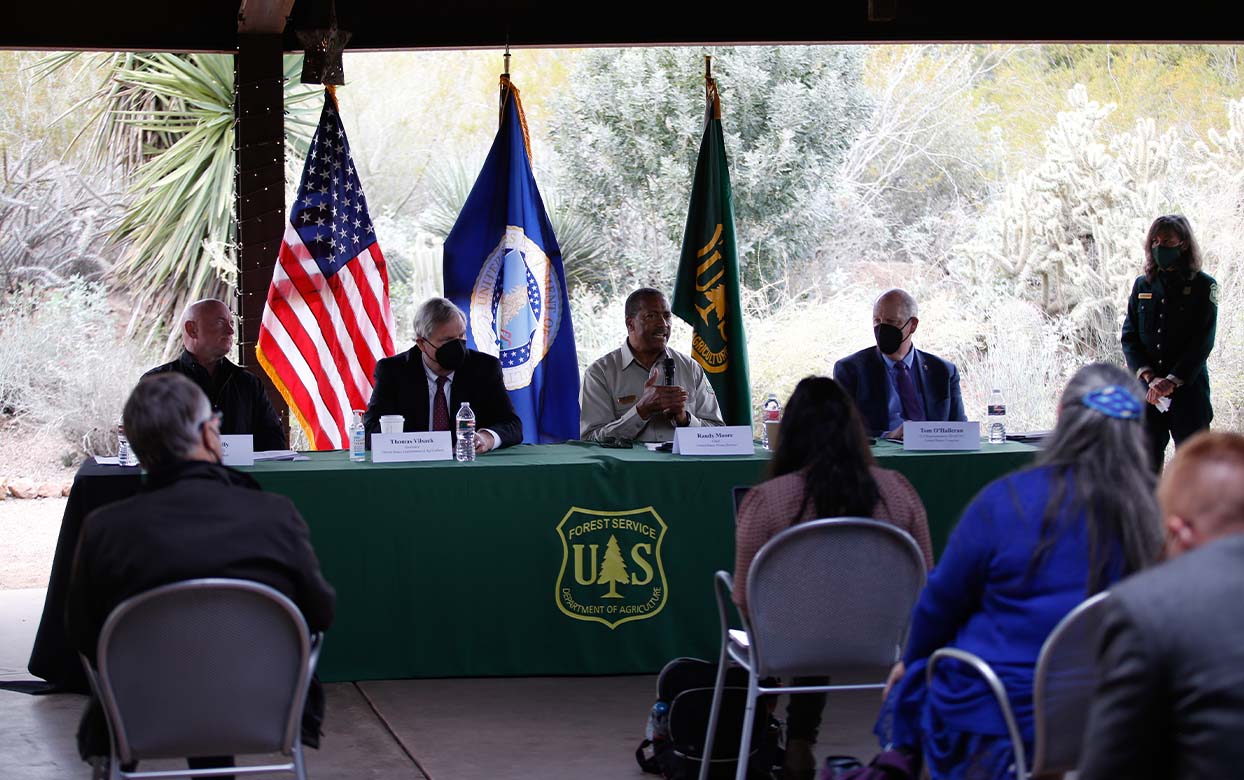U.S. Agriculture Secretary Tom Vilsack, Senator Mark Kelly of Arizona and Forest Chief Randy Moore visited Desert Botanical Garden on Tuesday to announce a 10-year multibillion-dollar plan to reduce the nation’s growing wildfire crisis.
In Arizona, the 10-year strategy calls for more aggressive forest thinning, or reducing trees and other vegetation that serves as tinder in the most at-risk areas, and watershed restoration programs across the state. Read more about the federal government’s 10-year plan to confront the wildfire crisis here.
The Sonoran Desert is at risk from increasingly intense and frequent wildfires. In 2021 alone, a series of wildfires ravaged across Arizona, including the Telegraph Fire near Superior last summer that burned 180,757 acres — which caused evacuations, highway closures, destroyed several buildings and a degraded the ecosystem.
Increased fuel loads, growing human populations and compounding effects of climate change in the arid Southwest have led to more fires — which threaten native plants and wildlife that are poorly adapted to survive their increasing frequency and intensity.
But it’s not all doom and gloom. There are many ways to help with the wildfire crisis, like volunteering with local organizations that remove invasive plants, planting native ones in your yard or space, or informing others of wildfire threats to their local communities.
Here’s a list of ways you can help reduce the risk of wildfire in the Sonoran Desert
1. Plant Native. Your yard, patio or balcony matters! Even small patches of plants can produce seeds that travel to open space/natural areas. Help insure those seeds are of native plants that are less likely to contribute to intense wildfires. Plus, they will provide a can supply of food for native insects and create habitat for birds and other wildlife. Learn more: aznps.com/grow-native/
2. Respect burned areas while they recover. Closures are put in place for the safety of recreationalists and for the health of the land. They can prevent injuries from unstable soil and collapsing vegetation, as well as give small seedlings a chance to grow and not be crushed. Latest closure info: dffm.az.gov/fire-restrictions-and-closures-across-arizona
3. Community (citizen) science. Join programs like the Metro Phoenix EcoFlora and contribute valuable information to land managers and organizations. dbg.org/partner-initiatives/ecoflora/
4. Join the Desert Defenders program to map and remove invasive plants: cazca.org/project/desert-defenders
5. Support the development of native seeds! Check out your local seed libraries, or grow your own and donate them.
6. Volunteer and get to know more of the great conservation organizations in Central Arizona here.
USDA Forest Service photo by Andrew Avitt.
First photo from left right, Arizona Senator Mark Kelly, Secretary of Agriculture Tom Vilsack, Forest Service Chief Randy Moore and Representative Tom O’Halleran.
A 10-year strategy, “Confronting the Wildfire Crisis: A New Strategy for Protecting Communities and Improving Resilience in American Forests” was announced at the Desert Botanical Gardens in Phoenix, January 18.
Arizona Senator Mark Kelly, Representative Tom O’Halleran, Secretary of Agriculture Tom Vilsack, and Forest Service Chief Randy Moore announced the strategy and discussed its national implications on how best to address the growing wildfire crisis.
